
Adam Gottlob Oehlenschläger was a Danish poet and playwright. He introduced romanticism into Danish literature. He wrote the lyrics to the song Der er et yndigt land, which is one of the national anthems of Denmark.
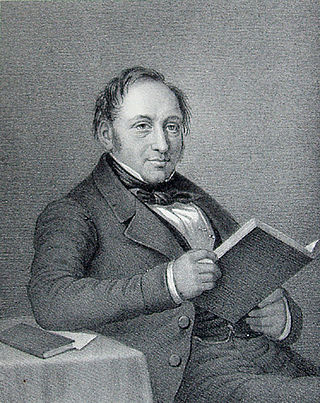
Johan Ludvig Heiberg, Danish poet, playwright, literary critic, literary historian son of the political writer Peter Andreas Heiberg (1758–1841), and of the novelist, afterwards the Baroness Gyllembourg-Ehrensvärd, was born in Copenhagen. He promoted Hegelian philosophy and introduced vaudeville to Denmark.

Christian Molbech was a Danish historian, literary critic, writer, and theater director. He was a professor of literature at the University of Copenhagen and was the founding editor of Historisk Tidsskrift
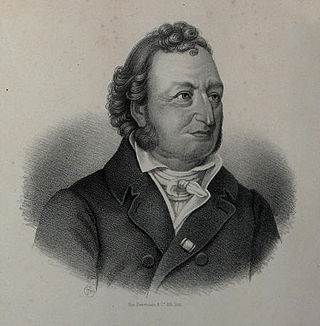
Knud Lyne Rahbek was a Danish literary historian, critic, writer, poet and magazine editor.
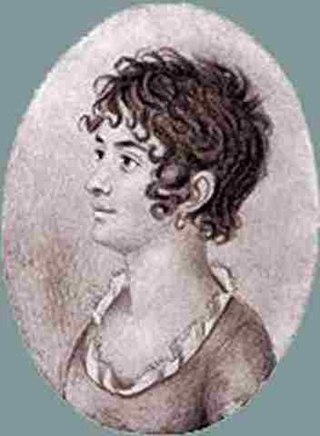
Karen Margrethe "Kamma" Rahbek, née Heger was a Danish writer, salonist and lady of letters.

Just Mathias Thiele was a Danish scholar and librarian. A central personage during the Danish Golden Age, he contributed to Danish cultural life in a number of capacities. He collected and published Danish folk tales with inspiration from the Brothers Grimm and founded the Royal Print Collection, today part of the Danish National Gallery. After the death of Bertel Thorvaldsen, he saved his archives and other papers and based on them he wrote his first biography.
Events from the year 1829 in Denmark.

Søkvæsthuset is a former Naval hospice located on Christianshavn Canal in the Christianshavn district of Copenhagen, Denmark. The listed building housed the Royal Danish Naval Museum indtil 2016. The collection has been moved to and is exhibited at the Arsenal Museum (Tøjhusmuseet) at Christiansborg.
Johan Christian Conradi was a German born, Danish master builder, contractor and architect.

Lorry is a former entertainment venue in the Frederiksberg district of Copenhagen, Denmark. Its history as an entertainment venue goes back to 1834 when the country house Enighedslyst was converted into a tea garden. The name refers to a later owner, Frederik Laurentius Feilberg, who was popularly known as Lorry. The listed building complex now houses TV2/Lorry, TV2's local news station for the Copenhagen area; a small theatre, Riddersalen; and a café.

Frederiksberg Ældre Kirkegård is a cemetery in Frederiksberg, Copenhagen. It was established in 1734 behind Frederiksberg Church.

Rahbeks Allé is a street located on the border between Frederiksberg and Vesterbro in Copenhagen, Denmark. It runs from Vesterbrogade in the northeast to the corner of Søndermarken in the southwest where it joins Pile Alle just before it turns into Valby Langgade on the border to Valby.The former Carlsberg brewery site which is under transformation into a new, dense neighbourhood is located on the south side of the street. Its north side is lined with low, mostly three-storey late-19th century apartment buildings with small front gardens.
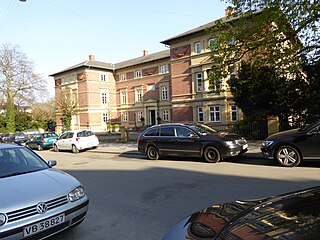
Frederiksberg Åndsvageanstalt is a former mental health treating institution for children located on Rahbeks Allé in the Frederiksberg district of Copenhagen, Denmark. It was founded in 1855 and moved to Ebberød in Birkerød in 1970. Its old main building from 1860 was designed by Ferdinand Meldahl and is listed. It now houses the clothing brand By Malene Birger. Another building has been converted into a daycare. The buildings are located adjacent to the former Carlsberg brewery site, which is under redevelopment into a new, dense neighborhood.
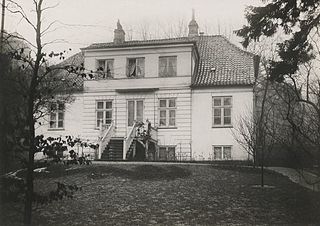
Ny Bakkegård is a Neoclassical country house located at Rahbeks Allé in the Frederiksberg district of Copenhagen, Denmark. The current house was built by later prime minister Carl Christian Hall in 1840. It was originally surrounded by open countryside but has now been enclosed by a perimeter block. A statue of Hall is located in Søndermarken on the other side of Pile Allé.

The Italian ambassador's residence in Copenhagen stands at the corner of Amaliegade with Fredericiagade in the Frederiksstaden neighbourhood of Copenhagen, Denmark.

Dannebrogsgade is a street in the Vesterbro district of Copenhagen, Denmark. It runs from Vesterbrogade in the north to Sønder Boulevard in the south and passes Istedgade on the way. It is closed to car traffic both at Otto Krabbes Plads and Litauens Plads. The buildings on the east side of the street at its northern end overlooks the Shooting Range Garden.

Vestergade 22 is a Neoclassical property in the Latin Quarter of Copenhagen, Denmark. The building is now part of the Politiken Hus complex. A commemorative plaque mounted on the wall of the gateway summarizes the history of the property, including the fact that Anders Sandøe Ørsted and his wife Sophie lived in the apartment on the first floor from 1805 to 1813. The building was listed on the Danish registry of protected buildings and places in 1959.

Hans Heger was a Danish judge. In 1771, he was appointed as one of the first 12 judges in the new Hof- og Stadsret. He was the father of Kamma Rahbek, actor Stephan Heger and royal librarian Carl Heger. His daughter Christiane Heger married Adam Oehlenschläger.

Store Kongensgade 59 is a late 18th to early 19th-century building complex, surrounding a central courtyard, situated on Store Kongensgade in Copenhagen, Denmark. It consists of two five-bay buildings fronting the street, two side wings and two rear wings. The northern (right) front wing dates from 1782 while the other buildings were added some time after 1800. The two buildings fronting the street were jointly listed in the Danish registry of protected buildings and places in 1918. Notable former residents include author Knud Lyne Rahbek, politicians Niels Rosenkrantz and Johan Sigismund von Møsting, landscape painter Georg Emil Libert, businessman Alfred Hage and actor Arthur Andersen.

Else Moltke (1888–1986) was a Danish countess, writer and women's rights activist. A keen contributor to newspapers and magazines from the early 1930s, she wrote mainly about historical figures, a topic which was behind Fra Bondehus til Herregaard. As a feminist, she recognized the difficulties women faced in achieving success. In 1941 she founded and ran a women's discussion club in Copenhagen which over the years achieved a membership of some 800. From the mid-1960s, Moltke published 14 books, the most successful of which was Fra herregård til kunstnerhus.




















